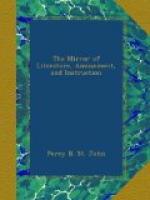Passing over Holbein, Sir Antonio Moore, Vandyke, Lely, Kneller, and Thornhill, we come to the lives of Hogarth—Wilson—Reynolds and Gainsborough—from which we select a few characteristic anecdotes and sketches. In noticing Hogarth’s early life, Mr. Cunningham has thrown some discredit on a book, which on its publication, made not a little chat among artists:—
“Of those early days I find this brief notice in Smith’s Life of Nollekens the sculptor. ’I have several times heard Mr. Nollekens observe, that he had frequently seen Hogarth, when a young man, saunter round Leicester Fields with his master’s sickly child hanging its head over his shoulder.’ It is more amusing to read such a book than safe to quote it. Hogarth had ceased to have a master for seventeen years, was married to Jane Thornhill, kept his carriage, and was in the full blaze of his reputation, when Nollekens was born.”
Among Hogarth’s early labours are his Illustrations of Hudibras, published in 1726. These were seventeen plates; and we have lately seen in the possession of Mr. Britton, the architect, eleven original paintings illustrative of Butler’s witty poem, and attributed to Hogarth.
From the notices of Hogarth’s portraits we select the following:—
“Hogarth’s Portrait of Henry Fielding, executed after death from recollection, is remarkable as being the only likeness extant of the prince of English novelists. It has various histories. According to Murphy, Fielding had made many promises to sit to Hogarth, for whose genius he had a high esteem, but died without fulfilling them; a lady accidentally cut a profile with her scissars, which recalled Fielding’s face so completely to Hogarth’s memory, that he took up the outline, corrected and finished it and made a capital likeness. The world is seldom satisfied with a common account of any thing that interests it—more especially as a marvellous one is easily manufactured. The following, then, is the second history. Garrick, having dressed himself in a suit of Fielding’s clothes, presented himself unexpectedly before the artist, mimicking the step, and assuming the look of their deceased friend. Hogarth was much affected at first, but, on recovering, took his pencil, and drew the portrait. For those who love a soberer history, the third edition is ready. Mrs. Hogarth, when questioned concerning it, said, that she remembered the affair well; her husband began the picture—and finished it—one evening in his own house, and sitting by her side.
“Captain Coram, the projector of the Foundling Hospital, sat for his portrait to Hogarth, and it is one of the best he ever painted. There is a natural dignity and great benevolence expressed in a face which, in the original, was rough and forbidding. This worthy man, having laid out his fortune and impaired his health in acts of charity and mercy, was reduced to poverty in his old age. An annuity of a hundred pounds was privately purchased, and when it was presented to him, he said, ’I did not waste the wealth which I possessed in self-indulgence or vain expense, and am not ashamed to own that in my old age I am poor.’




